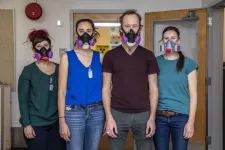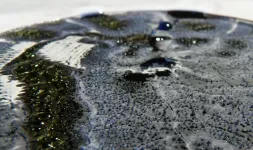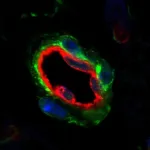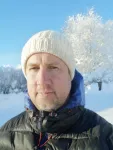(Press-News.org) Since element 99 - einsteinium - was discovered in 1952 at the Department of Energy's Lawrence Berkeley National Laboratory (Berkeley Lab) from the debris of the first hydrogen bomb, scientists have performed very few experiments with it because it is so hard to create and is exceptionally radioactive. A team of Berkeley Lab chemists has overcome these obstacles to report the first study characterizing some of its properties, opening the door to a better understanding of the remaining transuranic elements of the actinide series.
Published in the journal Nature, the study, "Structural and Spectroscopic Characterization of an Einsteinium Complex," was co-led by Berkeley Lab scientist Rebecca Abergel and Los Alamos National Laboratory scientist Stosh Kozimor, and included scientists from the two laboratories, UC Berkeley, and Georgetown University, several of whom are graduate students and postdoctoral fellows. With less than 250 nanograms of the element, the team measured the first-ever einsteinium bond distance, a basic property of an element's interactions with other atoms and molecules.
"There's not much known about einsteinium," said Abergel, who leads Berkeley Lab's Heavy Element Chemistry group and is an assistant professor in UC Berkeley's Nuclear Engineering department. "It's a remarkable achievement that we were able to work with this small amount of material and do inorganic chemistry. It's significant because the more we understand about its chemical behavior, the more we can apply this understanding for the development of new materials or new technologies, not necessarily just with einsteinium, but with the rest of the actinides too. And we can establish trends in the periodic table."
Short-lived and hard to make
Abergel and her team used experimental facilities not available decades ago when einsteinium was first discovered - the Molecular Foundry at Berkeley Lab and the Stanford Synchrotron Radiation Lightsource (SSRL) at SLAC National Accelerator Laboratory, both DOE Office of Science user facilities - to conduct luminescence spectroscopy and X-ray absorption spectroscopy experiments.
But first, getting the sample in a usable form was almost half the battle. "This whole paper is a long series of unfortunate events," she said wryly.
The material was made at Oak Ridge National Laboratory's High Flux Isotope Reactor, one of only a few places in the world that is capable of making einsteinium, which involves bombarding curium targets with neutrons to trigger a long chain of nuclear reactions. The first problem they encountered was that the sample was contaminated with a significant amount of californium, as making pure einsteinium in a usable quantity is extraordinarily challenging.
So they had to scrap their original plan to use X-ray crystallography - which is considered the gold standard for obtaining structural information on highly radioactive molecules but requires a pure sample of metal - and instead came up with a new way to make samples and leverage element-specific research techniques. Researchers at Los Alamos provided critical assistance in this step by designing a sample holder uniquely suited to the challenges intrinsic to einsteinium.
Then, contending with radioactive decay was another challenge. The Berkeley Lab team conducted their experiments with einsteinium-254, one of the more stable isotopes of the element. It has a half-life of 276 days, which is the time for half of the material to decay. Although the team was able to conduct many of the experiments before the coronavirus pandemic, they had plans for follow-up experiments that got interrupted thanks to pandemic-related shutdowns. By the time they were able to get back into their lab last summer, most of the sample was gone.
Bond distance and beyond
Still, the researchers were able to measure a bond distance with einsteinium and also discovered some physical chemistry behavior that was different from what would be expected from the actinide series, which are the elements on the bottom row of the periodic table.
"Determining the bond distance may not sound interesting, but it's the first thing you would want to know about how a metal binds to other molecules. What kind of chemical interaction is this element going to have with other atoms and molecules?" Abergel said.
Once scientists have this picture of the atomic arrangement of a molecule that incorporates einsteinium, they can try to find interesting chemical properties and improve understanding of periodic trends. "By getting this piece of data, we gain a better, broader understanding of how the whole actinide series behaves. And in that series, we have elements or isotopes that are useful for nuclear power production or radiopharmaceuticals," she said.
Tantalizingly, this research also offers the possibility of exploring what is beyond the edge of the periodic table, and possibly discovering a new element. "We're really starting to understand a little better what happens toward the end of the periodic table, and the next thing is, you could also envision an einsteinium target for discovering new elements," Abergel said. "Similar to the latest elements that were discovered in the past 10 years, like tennessine, which used a berkelium target, if you were to be able to isolate enough pure einsteinium to make a target, you could start looking for other elements and get closer to the (theorized) island of stability," where nuclear physicists have predicted isotopes may have half-lives of minutes or even days, instead of the microsecond or less half-lives that are common in the superheavy elements.
INFORMATION:
Study co-authors were Korey Carter, Katherine Shield, Kurt Smith, Leticia Arnedo-Sanchez, Tracy Mattox, Liane Moreau, and Corwin Booth of Berkeley Lab; Zachary Jones and Stosh Kozimor of Los Alamos National Laboratory; and Jennifer Wacker and Karah Knope of Georgetown University. The research was supported by the DOE Office of Science.
Founded in 1931 on the belief that the biggest scientific challenges are best addressed by teams, Lawrence Berkeley National Laboratory and its scientists have been recognized with 14 Nobel Prizes. Today, Berkeley Lab researchers develop sustainable energy and environmental solutions, create useful new materials, advance the frontiers of computing, and probe the mysteries of life, matter, and the universe. Scientists from around the world rely on the Lab's facilities for their own discovery science. Berkeley Lab is a multiprogram national laboratory, managed by the University of California for the U.S. Department of Energy's Office of Science.
DOE's Office of Science is the single largest supporter of basic research in the physical sciences in the United States, and is working to address some of the most pressing challenges of our time. For more information, please visit energy.gov/science.
The Arctic Ocean was covered by up to 900 m thick shelf ice and was filled entirely with freshwater at least twice in the last 150,000 years. This surprising finding, reported in the latest issue of the journal Nature, is the result of long-term research by scientists from the Alfred Wegener Institute and the MARUM. With a detailed analysis of the composition of marine deposits, the scientists could demonstrate that the Arctic Ocean as well as the Nordic Seas did not contain sea-salt in at least two glacial periods. Instead, these oceans were filled with large amounts of freshwater under a thick ice shield. This water could then be released into the North Atlantic in very short periods of time. Such sudden freshwater inputs could explain rapid climate oscillations for which no satisfying ...
What The Study Did: Data from the Centers for Disease Control and Prevention were used to look at changes in emergency department visits for mental health, suicide attempts, drug and opioid overdoses and outcomes of violence before and during the COVID-19 pandemic.
Authors: Kristin M. Holland, Ph.D., M.P.H., of the Centers for Disease Control and Prevention in Atlanta, is the corresponding author.
To access the embargoed study: Visit our For The Media website at this link https://media.jamanetwork.com/
(10.1001/jamapsychiatry.2020.4402)
Editor's Note: Please see the article for additional information, ...
What The Study Did: COVID-19 outcomes including hospitalization and in-hospital death were compared between people living with or without diagnosed HIV in New York State.
Authors: Eli S. Rosenberg, Ph.D., of the State University of New York in Rensselaer, is the corresponding author.
To access the embargoed study: Visit our For The Media website at this link https://media.jamanetwork.com/
(doi:10.1001/jamanetworkopen.2020.37069)
Editor's Note: The article includes conflict of interest and funding/support disclosures. Please see the article for additional information, including other authors, author contributions and ...
Mechanism for control of antibiotic production in soil bacteria is visualised for the first time by scientists at University of Warwick and Monash University
Research reported in Nature could lead to improved manufacturing of existing antibiotics, and open up opportunities to discover new ones
The majority of clinically used antibiotics are derived from soil bacteria, but can be hard to find because their production is switched off in laboratory cultures
The discovery of how hormone-like molecules turn on antibiotic production in soil bacteria could unlock the untapped opportunities for medicines that are under our very feet.
An international team of scientists working at the University of Warwick, UK, and Monash ...
ANN ARBOR, Mich. - The suicide rate among American adolescents has rose drastically over the last decade, but many at-risk youths aren't receiving the mental health services they need.
In fact, one of the greatest challenges is identifying the young people who need the most help.
Now, researchers have developed a personalized system to better detect suicidal youths. The novel, universal screening tool helps caregivers reliably predict an adolescent's suicide risk - alerting them to which ones need follow-up interventions - according to Michigan Medicine-led findings published in JAMA Psychiatry.
"Too many young people are dying by suicide and many at high risk go completely unrecognized and untreated," says lead author Cheryl King, Ph.D., ...
CAMBRIDGE, MA -- Twenty years ago this month, the first draft of the human genome was publicly released. One of the major surprises that came from that project was the revelation that only 1.5 percent of the human genome consists of protein-coding genes.
Over the past two decades, it has become apparent that those noncoding stretches of DNA, originally thought to be "junk DNA," play critical roles in development and gene regulation. In a new study published today, a team of researchers from MIT has published the most comprehensive map yet of this noncoding DNA.
This map provides in-depth annotation of epigenomic marks -- modifications indicating which genes are turned on or off in different types of cells -- across 833 tissues and cell types, a significant increase over ...
DALLAS - Feb. 3, 2021 - Gaining more fat cells is probably not what most people want, although that might be exactly what they need to fight off diabetes and other diseases. How and where the body can add fat cells has remained a mystery - but two new studies from UT Southwestern provide answers on the way this process works.
The studies, both published online today in Cell Stem Cell, describe two different processes that affect the generation of new fat cells. One reports how fat cell creation is impacted by the level of activity in tiny organelles inside cells called mitochondria. The other outlines a process that prevents new fat cells from developing in one fat storage area in ...
People with severe mental disorders have a significantly increased risk of dying from COVID-19. This has been shown in a new study from Umeå University and Karolinska Institutet in Sweden. Among the elderly, the proportion of deaths due to COVID-19 was almost fourfold for those with severe mental disorders compared to non-mentally ill people in the same age.
"We see a high excess mortality due to COVID-19 among the elderly with severe mental disorders, which gives us reason to consider whether this group should be given priority for vaccines," says Martin Maripuu, associate professor at Umeå University.
In the current study, the researchers studied data covering the entire Swedish population over the age of 20 during the period from 11 March to 15 June 2020. Among citizens ...
CABI scientists have updated the first major study of potential biological controls that could be used in the fight against the devastating fall armyworm in Africa. The research offers new insight into evidence of their efficacy in the field and increased availability as commercial products.
Indeed, the review, published in the Journal of Applied Entomology, includes many biocontrol products which are now featured in the CABI BioProtection Portal - a free web-based tool that enables users to discover information about registered biocontrol and biopesticide products around the world.
The fall armyworm ...
The behavior of the solvated electron e-aq has fundamental implications for electrochemistry, photochemistry, high-energy chemistry, as well as for biology--its nonequilibrium precursor is responsible for radiation damage to DNA--and it has understandably been the topic of experimental and theoretical investigation for more than 50 years.
Though the hydrated electron appears to be simple--it is the smallest possible anion as well as the simplest reducing agent in chemistry--capturing its physics is...hard. They are short lived and generated in small quantities and so impossible to concentrate and isolate. Their structure is therefore impossible to capture with direct experimental observation such as diffraction methods or NMR. Theoretical modelling has turned out to ...





